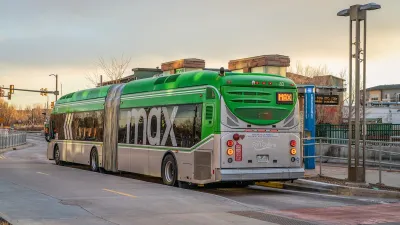Even when a community has thrown its full support behind a transit project, questions of funding and operations can create controversy. The next few months will be worth watching for Montgomery County, Maryland's proposed BRT system.
Kelly Blynn reports on an ongoing question about how to fund the operations of a proposed bus rapid transit line in Montgomery County.
"Montgomery County needs to find a funding stream in order to make its Bus Rapid Transit happen, and county executive Ike Leggett is exploring the possibilities. One of them is an independent transit authority, and while that may still work, the county needs to both vet it more thoroughly and weigh other options."
Leggett, however, already proposed an independent transit authority at the end of January, only to rescind that suggestion last week, "citing a need for a more in-depth community review," according to Blynn.
Reporting for the Washington Post, Bill Turque describes the response to the independent transit authority idea as "questions and withering criticism."
Blynn also describes the plan, approved in late 2013, as popular with Montgomery County residents. According to Blynn, "a survey of 400 residents in early 2014 found 71% of residents support BRT. They see BRT as a way to revitalize aging commercial corridors, make the area safer for people walking and on bikes, ease traffic congestion, and decrease air pollution."
Finally, Blynn states support for the idea of creating an independent transit authority with a dedicated funding stream: "Similar structures have worked well, primarily at regional scales, to provide laser-focus to build and finance new transit systems such as a streetcar in Pima County, AZ. Local funding and oversight for BRT may be more important than ever given the new Governor's expressed interest in cutting transit investment."
FULL STORY: How should Montgomery County fund and build Bus Rapid Transit?

Alabama: Trump Terminates Settlements for Black Communities Harmed By Raw Sewage
Trump deemed the landmark civil rights agreement “illegal DEI and environmental justice policy.”

Planetizen Federal Action Tracker
A weekly monitor of how Trump’s orders and actions are impacting planners and planning in America.

The 120 Year Old Tiny Home Villages That Sheltered San Francisco’s Earthquake Refugees
More than a century ago, San Francisco mobilized to house thousands of residents displaced by the 1906 earthquake. Could their strategy offer a model for the present?

In Both Crashes and Crime, Public Transportation is Far Safer than Driving
Contrary to popular assumptions, public transportation has far lower crash and crime rates than automobile travel. For safer communities, improve and encourage transit travel.

Report: Zoning Reforms Should Complement Nashville’s Ambitious Transit Plan
Without reform, restrictive zoning codes will limit the impact of the city’s planned transit expansion and could exclude some of the residents who depend on transit the most.

Judge Orders Release of Frozen IRA, IIJA Funding
The decision is a victory for environmental groups who charged that freezing funds for critical infrastructure and disaster response programs caused “real and irreparable harm” to communities.
Urban Design for Planners 1: Software Tools
This six-course series explores essential urban design concepts using open source software and equips planners with the tools they need to participate fully in the urban design process.
Planning for Universal Design
Learn the tools for implementing Universal Design in planning regulations.
Clanton & Associates, Inc.
Jessamine County Fiscal Court
Institute for Housing and Urban Development Studies (IHS)
City of Grandview
Harvard GSD Executive Education
Toledo-Lucas County Plan Commissions
Salt Lake City
NYU Wagner Graduate School of Public Service



























